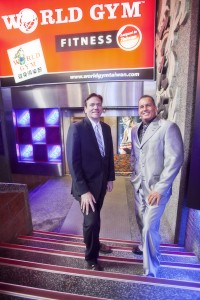
It was 8:30 a.m. EST when I received my first phone call from Michael Sanciprian. He was upbeat, talking a mile-a-minute about World Gym Taiwan and the growth of his business. He was on his way to do some follow-up business at another of his World Gym locations halfway across the country — he was on a bullet train going just over 200 miles per hour — he’d arrive within two hours, but it was still a 12 hour time difference (8:30 p.m.). Sanciprian said he never sleeps. He runs on success and building a business in a country where he barely speaks the language.
As I sipped my coffee he told me about how he had come to Taiwan, how his business was the most successful fitness club in the country and how it was ready to do the same in China … wait, did he just say he was going to build fitness clubs in China?
Since the dawn of time man has searched for new lands, new adventures and new opportunities. Columbus departed Spain to discover the “new world” in 1492. Magellan searched for new trade routes between 1519 and 1522. Henry Ford founded the Ford Motor Company in 1903, which changed the way people all over the world would eventually travel. Then, later that same year, the Wright Brothers revolutionized travel with their first human-controlled aircraft.
Man was created to pursue excellence and discover new methods of establishing business. It was a perpetuation of this innate instinct that John Caraccio and Michael Sanciprian launched World Gym Taiwan, the only fitness chain currently operating in the Asian country.
The business partners just finished opening their 24th club in Taiwan. Reportedly, the new location was performing 200 to 300 tours a day — its early sign-up period opened the club with 4,000 members. Caraccio and Sanciprian don’t operate their business like other Taiwanese companies; instead, they function just like clubs in America — paying employees the American equivalent and establishing an EFT system.
The clubs are flashy, sexy and cool for members. The personal trainers are regularly featured in GQ Taiwan and it’s not uncommon to find celebrities and high-end media outlets at club openings.
Caraccio and Sanciprian, although highly modest, have admittedly landed on a gold mine in East Asia. The next step, taking their business across the border — in the next five years, they plan to open 100 clubs throughout China.

Before the Far East
Going into Taiwan Caraccio was told that fitness clubs wouldn’t work. He had spent some time in Asia following college, but in the late 1980s he had moved back to the U.S. to work for a consulting company that focused on restaurants and hotels. “We were business people that had moved back from Asia, and what we realized was in the U.S. you could kind of see the future of Asia, in terms of the retail industry, leisure industry, health and fitness,” explained Caraccio. “At that time, there weren’t any fitness chains in Asia.”
Caraccio’s consulting company was doing restaurants — they brought Black Angus Steakhouse to Singapore. After Ray Wilson sold his part in 24 Hour Fitness, Caraccio and his consulting firm joined Wilson to bring California Fitness to Taiwan in 1996. Once the team found partners in Asia they opened and quickly decided to stick with Wilson’s strict EFT, dues-based model.
“Everyone said the same thing, fitness is more an American thing, it’s not going to work here,” said Caraccio. “Asians don’t like to sweat, they like massages — for them, health is going to get a massage — or going out drinking, that’s what they do to be social.”
After all the prior business was completed and the first location opened, in the first year it turned $10.5 million. “Basically it made back the initial investment in the first six months,” said Caraccio. “That was pretty much my entry into the fitness business. Just seeing the numbers and how the model worked, the excitement we were able to build and the fact that back in the U.S. all my friends and family have fitness membership cards, but in Asia, Taiwan and Hong Kong, no one had a membership card. I could see [memberships] were the future because [exercise] is universal — people care about their health and their well-being and staying in shape. That’s what gave me the vision and made me interested in building a fitness chain in Asia.”
Caraccio helped Wilson open four more California Fitness locations in Taiwan before he decided to venture out on his own. He put out an advertisement looking for a new partner to help him open a chain of World Gyms throughout Taiwan — which is where he met Sanciprian.
Sanciprian spent his entire life in gyms. When he was in high school his mom couldn’t afford for him to have a gym membership. “I was 14 years old and I wanted to work out,” he said. “I was always athletic, I played sports my whole life. I wanted to start working out, but I couldn’t afford the membership at Jack Lalanne’s.”
A friend of Sanciprian’s mother was a partner with Jack Lalanne. “He said I could clean the clubs and they’d give me a free membership. From there, the next step I took was at the front desk. From the front desk, I was working some customer service and a little as a trainer on the weekends when I was in high school.”
Following high school Sanciprian’s career in fitness continued to prosper. “Where it really took off was when I went to California Family Fitness with Russ Kuhn and Larry Gurney,” he said. “I started with them at one location and Russ Kuhn was kind of a mentor over the years.” Sanciprian moved from sales, to sales manager, to GM and regional sales manager. “I basically worked up the ladder the good ole fashioned way. That’s basically the simple format — the good ole fashion way.”

Fitness Industry Taiwan
Before Caraccio and Sanciprian the fitness industry was relatively non-existent in Taiwan. The belief, according to Caraccio’s non-believers, was that Asians didn’t like to sweat — they believed in holistic fitness, such as meditation and massage. Getting on a treadmill and sweating out calories for 20 minutes didn’t make any sense.
Sanciprian said that the first transition in launching successful gyms was developing a marketing strategy that appealed to the Taiwanese. “There are some clubs, you could take a three-mile radius and have 700,000 people,” explained Sanciprian. “You can take a one-mile radius and have 150,000 people to probably 300,000 people, depending on the area.”
The partners discovered that there was an education problem in bringing people into their clubs. However, when the clubs opened there was “a big boom with a lot of excitement, doing huge numbers,” said Sanciprian. “Now, what do I do in the place? Educating the market, obviously that’s where personal training comes in. When you see a country that is very affluent, loves foreign product and you have a penetration rate less than 1 percent, you can see that there is still a huge demand, and that’s what I saw five years ago. The penetration rate isn’t even closely penetrated yet.”
World Gym Taiwan saw the excitement behind the opening of a club and decided to capitalize on the energy. The citizens would stand around the block in lines to sign up for a gym membership because they were told it was “cool” or a “social gathering place.”
“The business itself does not change,” explained Sanciprian. “There is no difference what-so-ever. I think some people out here try and make it different — try to cater to Asians or put massage in, put in juice bars and lounges, and a lot of people did that, and a lot of operators got their ass kicked. They try to cater to the Asian way.
“When it comes to ourselves, we just do it the same way as we do in America. There is absolutely zero difference, from the way we treat our staff, the way we do everything is 100 percent the same way we do it [in America].”
As for a few differences, Taiwan seemed to be right behind the U.S. as far as trends were concerned. “Aerobics is a little more popular here, so you have more classes,” said Caraccio. “There are certain amenities, a lot of our clubs have Jacuzzis, steams and saunas.”
“The biggest differences can be on the real estate side, because real estate can be very expensive in Asia, or can be very, very affordable if you understand the way of the land,” said Sanciprian.
“When business was really booming during that initial phase, a lot of operators got into very high rent,” explained Caraccio. “They would take the most expensive corner of the busiest street, running a prepaid business. So, anytime you had a hiccup in the economy — which eventually happened — it shook them all out. The main reason they couldn’t survive was they got into this massive rent.”
World Gym Taiwan, like most of its other business practices, focused on operating clubs like they did clubs in the U.S. Aside from using EFTs, it placed the majority of its clubs in residential strip malls that had a consistent high population volume. “I always have a model that I follow, and keep everything down to a certain budget,” said Caraccio. “When the financial crisis occurred, I ended up renegotiating for better locations, and even moving some locations. One of the big differences, in Asia, it’s easy to get sucked into believing you have to be in the Grade A location. They ask for deposits at six or 12 months, and the know how we developed has been being patient and then finding locations that fit our budget and looking for the good deals. Looking for places that were off the beaten path — still in booming downtown areas — but not first floor space. Maybe you’re on the second or third floor, maybe you’re in the basement.”
Sanciprian said that some of the basement locations worked out best for the clubs. They can manage rent in a basement, but still install a giant gorilla sign, synonymous with World Gym, at street level where it catches the eye of everyone on the street.
“In residential areas in Taiwan, it’s cheaper,” said Sanciprian. “One of our most profitable clubs in the last five years isn’t located somewhere special, it’s a heavy residential area, located in a mall area. It’s off the beaten path up against the mountains, but it’s heavy residential.” The club still uses massive signage that World Gym Taiwan has become known for, but it draws its clientele just like clubs in America would. “We can get a great location at a great rate, and we know how to market to residential,” Sanciprian continued. “In Asia it’s all about traffic because there are so many people walking the streets. In real estate, the biggest thing for me was realizing we can go into residential areas and make a huge impact, because this is where they live anyway, and no one else really caught onto that.”
World Gym Taiwan will also use slightly different techniques to attract prospective clients. For each individual club opening it holds elaborate parties (see video) with celebrities and top media outlets — last year GQ created a custom video documenting one of the club openings.
Once a club is open, World Gym Taiwan uses employees out on the sidewalk in front of the club to bring passersbys in for a tour — each person that comes in for a tour is automatically entered for a chance to win a Harley Davidson motorcycle.
The Asian Marketplace
Once Caraccio saw the numbers from the first California Fitness, he knew he was onto something big. After leaving California Fitness, where he was operating as a GM, he posted an advertisement looking for a business partner.
“Michael caught on very quickly,” explained Caraccio. “It was more him helping me create a better brand, tighten operations, develop a stronger staff and really push us to grow more. When we first started talking we had three clubs, but by the time he actually got here we had five clubs. Now we are at 24 clubs, so Michael basically hit the ground running and he’s very confident in his ability in performing and building business at each club. I have to slow him down, basically,” he laughed.
World Gym Taiwan has set three-year and five-year goals. The three-year goals include everything that is currently being executed. “There is one plan for Taiwan and there is one plan for China,” explained Sanciprian. “For Taiwan, it’s very clear that our goal, within three years, we should be about 50 locations. But, within the next 24 months we are looking to take the company public in Taiwan. So, 50 locations will put us anywhere between $120 million to $150 million in revenue.”
In order for all this to go off without a hitch, everything has had to be restructured and modified, from new HR procedures and POS systems. “Everything we do has to be in Chinese,” explained Sanciprian. “You can’t just take an American product, or an American system and just stick it in. You have to develop your own products, your own system. That’s basically what we’ve been doing to get to that launching point.”
In the five-year plan Caraccio and Sanciprian hope to take business into China and be one of the first fitness clubs ever to break ground in the country. “I was in China even before I came to Taiwan,” said Caraccio. “Obviously, investors that are looking for new business are excited about China. It’s always been in the back of our mind that we’re eventually going to launch our China plan.
“If you look at Taiwan, previously a province of China, Taiwan is only one province where China has 19 provinces and some of these provinces are as wealthy as Taiwan. Just the amount of potential growth in China is unlimited. We are looking for scalability and potential, which are what investors are looking for. At the same time, in the Chinese culture, everything is in Mandarin, so we already have a team that is ready to go into China for development.”
Each bit of the China operation has yet to be completed, but for World Gym Taiwan, it has assembled its team to make a move immediately after finalizing negotiations with World Gym International, the overseeing company for World Gym franchisees globally.
According to Sanciprian, World Gym Taiwan is prepared to launch 100 World Gym locations in China in the next five years — which isn’t hard to believe from what the company has accomplished in Taiwan. Sanciprian reports that personal training has increased by 300 percent in the last 24 months — earning somewhere around $120,000 a month per club in personal training.
World Gym Taiwan’s business is simple math, just like its move from Taiwan to China — if there are just over 23 million people in Taiwan, and there are over one billion people in China … you do the math.
By Tyler Montgomery
Stay ahead in the fitness industry with exclusive updates!
Rachel Zabonick-Chonko is the editor-in-chief of Club Solutions Magazine. She can be reached at rachel@peakemedia.com.











